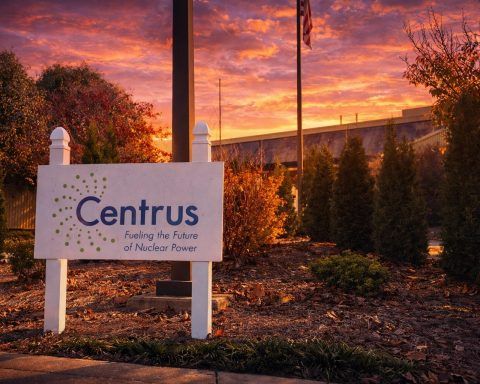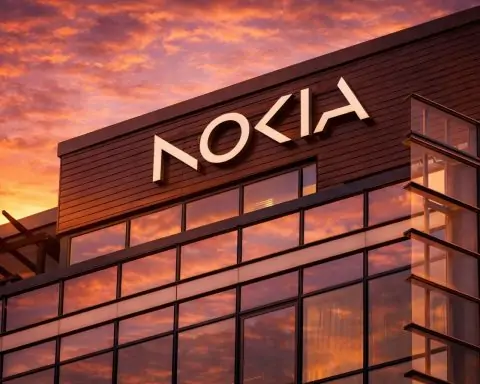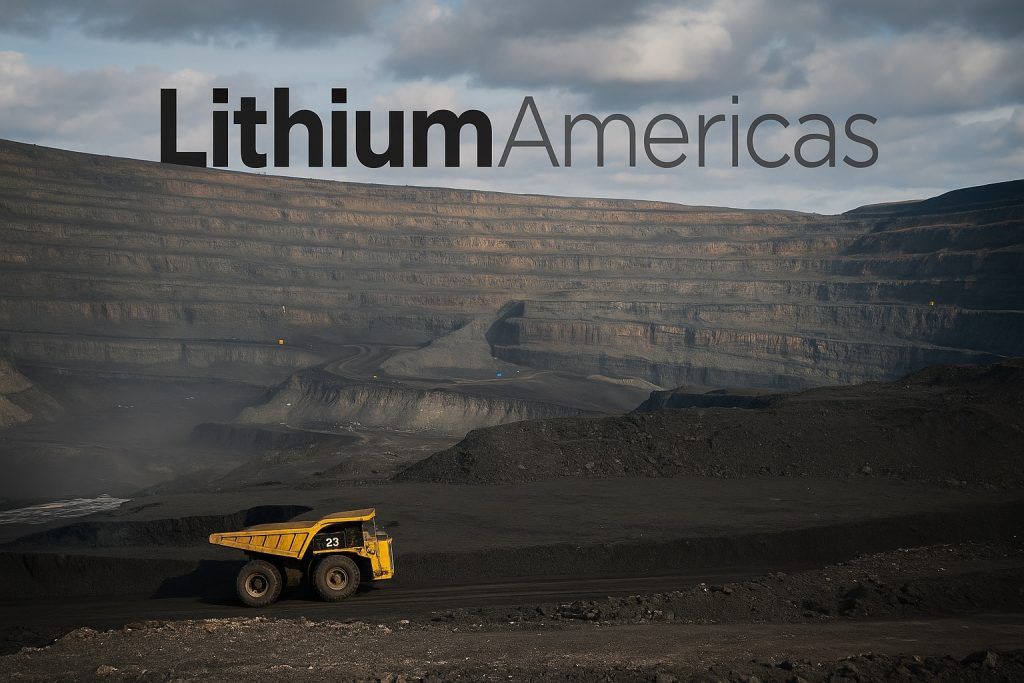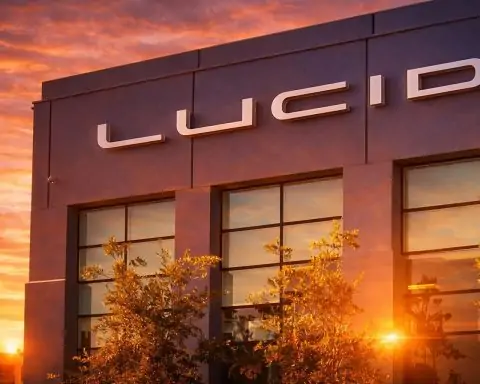- Epic Rally: D-Wave Quantum Inc. (NYSE: QBTS) has surged from roughly $1 per share in late 2024 to about $46.75 at its mid-October 2025 peak – a +3,000% leap in under a year [1]. Even after a pullback to the mid-$30s this week, the stock remains up around 300% year-to-date and +70% over the past month [2]. A $1,000 investment a year ago would now be worth well over $30,000 [3], underscoring the frenzy around this quantum computing play.
- Volatile Swings: After hitting an all-time high above $45 in mid-October, QBTS quickly retraced ~25% as early investors took profits, dropping from the high-$40s down into the $30s within days [4]. The stock closed last week at $32.65 on Friday, then jumped to around $34 in pre-market trading Monday [5]. Intra-day swings of 10–20% have become common, making D-Wave one of the market’s most volatile stocks. The 52-week range spans from about $0.97 to $46.75, reflecting its transformation from a penny stock to a mid-cap virtually overnight [6].
- Government Investment Rumors: Quantum computing shares got a boost late last week after The Wall Street Journal reported President Donald Trump’s administration is in talks to take equity stakes in companies like D-Wave, IonQ, and Rigetti in exchange for federal funding [7]. Following the Oct. 22 report, D-Wave’s stock and its peers surged between ~8% and 16% on Thursday [8]. (A U.S. Commerce Department official denied any active negotiations [9], but the mere prospect of Washington backing quantum tech fueled investor excitement.)
- Major Moves by D-Wave: On Oct. 20, D-Wave announced it will redeem all ~5 million outstanding public warrants (from its SPAC merger) by Nov. 19 as part of a plan to streamline its capital structure [10]. Warrant holders must either exercise their warrants (buy shares at $11.50) or let them expire worthless; if all are exercised, about 7.2 million new shares (~2% dilution) would be issued [11]. The move aims to eliminate an overhang of potentially dilutive securities – news that initially lifted QBTS about 4% in pre-market trading [12].
- European Deal & Real-World Breakthroughs: D-Wave is starting to convert its tech into revenue. Last week (Oct. 15), the company inked a €10 million (~$11.6M) deal with Switzerland’s Quantum Technology (SQT) to deploy a state-of-the-art Advantage2 quantum annealing computer (4,400+ qubits) in Italy [13]. This marks D-Wave’s first major European sale, expanding its global footprint. The company also showcased a real-world use case in a pilot with North Wales Police (UK): its hybrid quantum platform solved an emergency response optimization problem in 4 minutes instead of 4 months, cutting average dispatch times by ~50% [14]. CEO Alan Baratz hailed it as proof that “hybrid-quantum computing…is beginning to show real-world potential” [15] – a milestone that boosts the technology’s credibility for practical applications.
- Analyst Sentiment: Despite zero profits to date, Wall Street analysts have grown bullish on D-Wave. Eleven out of twelve analysts covering QBTS rate it a “Buy”, according to recent industry reports [16]. Just last week, Roth Capital doubled its price target from $20 to $50 (reiterating a Buy) after the European contract, saying the deal “adds support” to the view that D-Wave’s tech is gaining “practical traction” with real customers [17]. However, optimism is tempered by valuation worries – the average 12-month price target is only ~$27 [18], well below the current trading price. In other words, even bullish analysts suspect the stock has gotten ahead of itself.
- Quantum Computing Frenzy: D-Wave’s dizzying rise is part of a broader “quantum gold rush” in 2025. Investors hungry for the “next big thing” after the AI boom have piled into quantum computing names, sending pure-play stocks like IonQ and Rigetti up hundreds or even thousands of percent over the past year [19]. Macro tailwinds have super-charged the enthusiasm – a Federal Reserve interest rate cut in mid-October sparked a rally in high-growth tech stocks, and JPMorgan’s announcement of a $1.5 trillion tech investment initiative (naming quantum computing alongside AI) sent the tiny quantum sector into overdrive [20] [21]. Even NVIDIA CEO Jensen Huang recently declared quantum computing at an “inflection point” for solving real-world problems [22]. These headlines have fed a FOMO-fueled surge in quantum stocks.
- Lofty Valuation & Risks: At its peak, D-Wave’s market capitalization neared $13–14 billion, despite 2025 revenues likely under $30 million – a nosebleed 400× sales multiple [23] [24]. One market commentary flatly stated QBTS at $40+ looked “significantly overvalued by virtually any measure” [25]. The stock’s rise has been driven more by “speculation and momentum” than fundamentals, analysts warn [26]. Technical indicators show the shares have frequently been “overbought”, and a new 2× short ETF (NYSE: QBTZ) even launched this month to let bearish traders bet against D-Wave’s rally [27]. Extreme volatility means investors should brace for sharp moves in either direction [28].
- Forecasts:Near-term, expect the turbulence to continue. Market watchers say QBTS could remain a rollercoaster as hype battles reality – rapid swings (up or down) are likely as new headlines emerge and traders take profits or pile in [29]. Short-term catalysts like any confirmation (or refutation) of U.S. government investment, or D-Wave’s next earnings report, could spark outsized reactions. Mid-term, the stock’s trajectory will hinge on execution: Can D-Wave turn quantum breakthroughs into substantial revenue growth? Bulls argue that D-Wave’s first-mover advantage in commercial quantum computing could translate into exponential growth – and enormous rewards for early investors – if the technology achieves its promise [30]. Indeed, some experts predict that as quantum computing matures, pioneers like D-Wave are likely to see further growth [31]. But skeptics counter that any misstep or slower-than-expected progress could bring a harsh reality check, given the stock’s frothy valuation [32] [33]. In essence, QBTS offers huge upside if D-Wave’s quantum leap succeeds – and equally huge downside if the current euphoria proves premature.
D-Wave’s Rocket Ride: From Penny Stock to Market Phenomenon
Few stocks have soared like D-Wave Quantum in 2025. After languishing under $1 per share in late 2024, D-Wave’s stock went parabolic this year [34]. It reached a record intraday high of $46.75 on October 15 [35], making early investors a fortune – in fact, a $1,000 stake a year ago grew to over $30,000 at the peak [36]. Such exponential gains are virtually unheard of outside of the most speculative arenas (comparable to crypto mania) [37], and they vaulted D-Wave into the spotlight as one of 2025’s top-performing stocks.
By late October, QBTS had pulled back from its highs but was still trading around the mid-$30s [38]. Even at that level, the stock is up roughly +300% in 2025 (year-to-date) and an astonishing +2,500–3,000% year-over-year [39]. This meteoric rise has been fueled by excitement over quantum computing’s potential – and, to a large extent, by a fear of missing out. D-Wave has become the poster child of a broader quantum stock frenzy, as investors chase what many see as the “next big thing” after artificial intelligence [40].
Not only D-Wave, but other quantum players like IonQ (IONQ) and Rigetti (RGTI) have seen their shares skyrocket by triple or even quadruple digits percentage-wise in the past year [41]. By early October, all major pure-play quantum computing firms were up dramatically year-over-year, some by well over 1,000% [42]. The rally has been stoked by a steady drumbeat of positive news: breakthrough tech demos, new partnerships, rising government interest, and macroeconomic boosts. For instance, when the U.S. Federal Reserve cut interest rates in mid-October, it lifted sentiment across growth tech stocks (D-Wave included) [43]. Just days later, JPMorgan unveiled a massive $1.5 trillion initiative to fund frontier technologies like quantum computing [44], sending the niche quantum sector into overdrive. In the same vein, even mainstream tech leaders are voicing optimism – NVIDIA’s CEO Jensen Huang recently proclaimed that quantum computing is at an “inflection point” where real-world impact is within reach [45].
All of these factors combined to create a perfect storm of investor enthusiasm around D-Wave. However, the wild ride has come with equally wild volatility. The stock’s rapid ascent has at times been untethered from traditional valuation logic, and its daily trading action has grown frenzied. On some days, QBTS has swung 10–20% intraday, and volumes have spiked to many times the normal levels [46]. By mid-October, technical gauges like the Relative Strength Index were flashing “overbought,” and a new leveraged inverse ETF (NYSE: QBTZ) even launched on October 7 to let bearish investors bet against D-Wave’s rally [47] – a striking sign of how speculative (and polarized) the sentiment around this stock has become.
Recent News: Big Headlines Drive Big Moves
In the past several days, major news developments have kept D-Wave in the headlines – and its stock on a rollercoaster. Perhaps the most buzzworthy was a report that the U.S. government might directly invest in quantum computing companies. On October 22, The Wall Street Journal broke news that President Trump’s administration is in talks to take equity stakes in several quantum firms – including D-Wave, IonQ, and Rigetti – in exchange for at least $10 million in federal funding for each [48]. The idea is part of Washington’s push to secure U.S. leadership in critical technologies. While the Commerce Department said it’s “not currently negotiating” with those companies [49], the mere rumor of Uncle Sam becoming a shareholder electrified the market. The next day (Oct. 23), quantum stocks jumped sharply, with D-Wave, IonQ, and others popping between +7.8% and +16% intraday on the news [50]. “The quantum computing offers the chance to really revolutionize the U.S. economy… it’s the administration doing things in an unconventional way,” noted IG’s Chief Market Analyst Chris Beauchamp, explaining why investors view potential government backing as a game-changer [51]. Even though no official deal has been confirmed, traders rushed in on hopes that federal investment could accelerate quantum breakthroughs – and validate the sky-high valuations in the sector.
D-Wave also delivered company-specific news that moved its stock. On Monday, Oct. 20, the company announced a plan to redeem all of its remaining public warrants [52]. These warrants were a legacy of D-Wave’s SPAC merger, and they give holders the right to buy shares at $11.50. D-Wave’s move forces warrant holders to either exercise that right by November 19 or lose it, effectively clearing out the warrants. If all are exercised, about 7.2 million new shares will be issued (roughly a 2.1% increase in shares outstanding) [53]. The market viewed this capital structure cleanup as a positive step to remove uncertainty and dilution overhang. In fact, D-Wave’s stock spiked about 4% pre-market on Oct. 20 when the news hit [54], though it gave up some of those gains later amid broader market volatility. By simplifying its equity structure now, the company may be positioning itself for future financing needs or simply giving existing shareholders more clarity. It’s a tactical move that many high-flying tech startups pursue to strengthen investor confidence.
Another significant milestone came on the commercial front. Late the prior week (Oct. 15), D-Wave announced a headline-grabbing European deal that validates growing international interest in its quantum technology. The company signed a €10 million (~$11.6 million) agreement with Swiss Quantum Technology (SQT) to deploy a cutting-edge Advantage2 quantum annealing system in Europe [55]. The machine, featuring over 4,400 qubits, will be installed at a new quantum computing center in Italy as part of the country’s “Q-Alliance” tech hub initiative. Under the deal, SQT will get access to 50% of the system’s runtime over five years (with an option to purchase the machine later), while D-Wave will make the other half of the computing time available via its cloud platform [56]. D-Wave CEO Alan Baratz touted the agreement as a breakthrough in expanding global access to the company’s quantum solutions, noting it’s D-Wave’s first major hardware sale in Europe. Analysts also cheered the news: research firm Roth Capital said the contract “adds support” to the view that D-Wave’s technology is gaining real commercial traction and solving real problems, which led Roth to sharply lift its price target on the stock (more on that below) [57]. For D-Wave – which until now has mainly deployed systems in North America – the European expansion is a vote of confidence that could open the door to more international business.
Beyond that big sale, D-Wave has been busy showcasing practical use cases and partnerships, helping justify some of the hype around its stock. At its “Qubits 2025” user conference in late September, the company highlighted a remarkable pilot project with the North Wales Police in the UK. Using D-Wave’s hybrid quantum-classical computing platform, the police optimized their emergency response routing in minutes rather than months, reportedly cutting average response times by about 50% [58]. “Hybrid-quantum computing can offer the speed, precision and intelligence needed… [and] is beginning to show real-world potential,” CEO Alan Baratz said of the achievement [59]. Such concrete success stories demonstrate that quantum computing, while still early, is starting to deliver tangible benefits in complex, real-world scenarios – a key proof point for investors and customers alike.
D-Wave has also announced a flurry of partnerships and R&D collaborations that underscore global interest in its technology. For example, the company joined a new quantum innovation hub in Lombardy, Italy, linking into the same Q-Alliance network as the aforementioned deal [60]. In Asia, D-Wave reported an 83% jump in APAC bookings year-over-year, thanks to pilot projects with major firms like Japan Tobacco (applying quantum machine learning for drug discovery) and NTT Docomo (optimizing mobile network traffic) [61]. It is also working with NASA’s Jet Propulsion Lab on advanced cryogenic packaging for future 100,000-qubit processors, and it signed an MOU with Yonsei University in South Korea to explore installing an Advantage2 system there [62]. While many of these projects are still experimental, each new collaboration adds to D-Wave’s credibility – and potential future revenue pipeline – reinforcing the bullish narrative around the stock [63]. In short, nearly every week D-Wave is giving investors something new to chew on, be it a high-profile deal, technical milestone, or strategic alliance. Those positive headlines have undoubtedly played a role in the stock’s momentum, creating a sense that “quantum’s moment” has arrived at last [64].
Analyst Views: Hype vs. Fundamentals
With QBTS stock on a tear, analysts and experts have been weighing in on both its promise and its perils. On Wall Street, coverage of D-Wave has swung surprisingly bullish given the company’s early-stage status. As of this month, 11 out of 12 analysts following D-Wave rate the stock a Buy (or equivalent) [65] – an unusually high consensus of optimism. These analysts argue that D-Wave, founded in 1999, is finally on the cusp of translating two decades of R&D into a viable commercial business [66]. They point to the company’s recent milestones – like the European contract and real-world use cases – as evidence that D-Wave’s quantum annealing technology is gaining real adoption beyond the lab [67]. In fact, some bullish analysts frame D-Wave’s potential in epochal terms: they see it as a pioneer that could maintain a first-mover advantage in quantum computing, in the same way early leaders did in cloud computing or AI, potentially yielding outsized rewards for investors who get in early [68].
This upbeat sentiment has led to a flurry of price target upgrades in recent weeks. For example, in early October, B. Riley Securities hiked its target price for QBTS to $33 (from the mid-$20s previously) after noting D-Wave’s rapid technical progress and solid cash runway to fund growth [69]. Then on Oct. 16, Roth MKM (Roth Capital) made an even more dramatic call – it doubled its target from $20 to $50 and reiterated a Buy rating [70]. Roth’s analyst Sujeeva De Silva specifically cited D-Wave’s new European deal as a catalyst, saying the contract “adds support to [the] view that D-Wave’s quantum annealing technology is gaining practical traction.” He highlighted that real customer wins and use cases are finally emerging, suggesting D-Wave is converting its decades of research into a nascent commercial opportunity [71]. In essence, the bullish thesis is that D-Wave is at the forefront of a revolutionary tech wave – one that could eventually reshape industries from logistics to drug discovery – and that the company’s long head start in quantum annealing gives it a chance to ride that wave to massive growth.
However, even the cheerleaders acknowledge some important caveats. Most notably, there’s a glaring disconnect between D-Wave’s soaring stock price and its financial fundamentals. The company remains deeply unprofitable and is only expected to generate on the order of $25–30 million in revenue for 2025 [72] – a pittance compared to its multi-billion-dollar market valuation. At the recent peak near $46, D-Wave’s market cap exceeded $13 billion, putting the stock at well over 400× trailing sales [73]. Such a ratio is virtually unheard of and implies that investors are betting on extraordinarily rapid future growth. One Nasdaq commentary bluntly stated D-Wave’s valuation at $40+ was “significantly overvalued by virtually any measure” [74]. And while analysts have been raising their targets, they still generally lag behind the market price. The consensus 12-month target is around $27 [75] – which is 30–40% lower than where the stock is currently trading in the mid-$30s. In fact, when QBTS was at its height, many analysts’ targets in the high-$20s were barely half the market price [76]. This gap suggests that even optimistic experts think the stock’s momentum has outpaced reality. Yes, they’re positive on D-Wave’s technology and long-term prospects, but they also caution that the valuation has become hard to justify unless the company executes flawlessly and the quantum industry booms faster than anticipated [77].
Several analysts and investors have urged caution in light of the stock’s vertical rise. D-Wave’s own management has been candid that quantum computing is still in its infancy commercially, and that meaningful revenue growth will take time [78]. The CEO, Alan Baratz, often reminds stakeholders that while the progress is exciting, the technology is not yet at the point of generating large, repeatable revenues – it’s early days for quantum adoption. This sobering perspective is echoed by market veterans who’ve seen similar hype cycles in tech. They warn that if D-Wave stumbles in executing its growth plans – or if the broader quantum field advances more slowly than investors hope – the stock could face a harsh comeuppance. “The recent surge could reverse just as quickly if it’s purely momentum without clear profit traction soon,” one commentator warned [79]. In other words, D-Wave’s stock is currently priced for perfection; any disappointment could lead to a swift and painful correction. The presence of the new inverse ETF (QBTZ) is telling – it shows a faction of the market is actively positioning for a possible downturn, essentially shorting the hype.
In sum, the expert view on QBTS is a tale of two narratives. The bulls see a groundbreaking technology company at the vanguard of a computing revolution – a company that, if it fulfills its potential, could justify today’s lofty valuation and then some. The bears (or realists) see a tiny revenue base and a stock disconnected from fundamentals, fueled by speculative zeal that can evaporate without warning. Both agree on one thing: D-Wave is making impressive strides in quantum computing. Where they differ is how much of that future success is already baked into the stock’s price – and how much risk investors are shouldering at this early stage.
Outlook: Quantum Dreams vs. Market Reality
Looking ahead, what’s next for D-Wave and its red-hot stock? In the short term, most experts predict the ride will remain bumpy. The stock’s recent behavior – soaring to new highs on optimism, then plunging on profit-taking – is characteristic of a high-momentum, news-driven trade. As such, volatility is likely to persist. “Investors should brace for sharp moves in either direction,” one analysis cautioned [80], noting that upside surprises (like a big contract or policy support) could send QBTS higher, while any negative development (a tech hiccup, a broader market selloff, etc.) could trigger a rapid slide. The ongoing speculation about U.S. government investment is a wildcard; if an actual deal materializes, it would be a strong bullish catalyst, whereas no deal or a denial could deflate some of the hype. Likewise, D-Wave’s upcoming earnings (expected in a few weeks) will be closely watched for any signs of revenue uptick or improved guidance. Even though the company’s quarterly numbers are small in absolute terms, management’s commentary on customer momentum and backlog could sway sentiment.
From a technical analysis perspective, traders are eyeing key price levels. The stock’s dip into the mid-$30s after its peak suggests this area might act as an initial support (helped by the fact it’s around D-Wave’s 20-day moving average) [81]. If selling pressures mount, analysts see potential support in the high-$20s – roughly where the stock consolidated before its last big run-up [82]. On the resistance side, the mid-$40s (the recent high zone) is an obvious ceiling that would require a fresh wave of buying to break. Psychological round numbers like $50 could also be hurdles if the stock rallies again [83]. In essence, the technicals reflect a stock that went nearly vertical and is now searching for equilibrium amid vastly higher price territory than anything in its past.
In the mid to long term, D-Wave’s fate will likely hinge on whether it can deliver real growth commensurate with its valuation. The good news for bulls: quantum computing truly does have transformative potential, and D-Wave is one of the few publicly traded pure-plays in this arena. If over the next 1–2 years D-Wave can sign more paying customers, scale up its systems (e.g. move toward that future 100,000-qubit processor it’s developing with NASA), and perhaps even approach cash-flow breakeven with the hefty cash pile it raised in 2025, then the current stock price may end up looking justified – or even cheap. As Motley Fool recently noted, quantum computing is still in its infancy, but “once the tech matures, IonQ and D-Wave shares are likely to see further growth.” [84] In other words, the long-term addressable market for quantum is enormous (spanning industries from pharmaceuticals to finance), so early leaders like D-Wave could ride a secular wave of demand in the back half of this decade.
However, the risks are equally large. D-Wave’s valuation leaves no margin for error – the company must execute almost perfectly to grow into its market cap. Any indication that quantum adoption is slowing, or that competitors (like IonQ’s gate-model computers or big players like Google/IBM) are outpacing D-Wave, could shatter investor confidence. Furthermore, macro factors such as rising interest rates (if the Fed changes course) or reduced risk appetite could disproportionately hurt high-multiple stocks like QBTS. Skeptics argue that a lot of best-case scenario is already priced in. As one analysis put it, D-Wave’s stock represents a “quantum leap” of faith by investors – one predicated on future breakthroughs that may take years to fully materialize [85].
Bottom line: D-Wave Quantum has captured the public markets’ imagination with its dramatic stock ascent and frontier technology. The company stands at the intersection of genuine scientific innovation and speculative market exuberance. In the coming months, expect D-Wave’s stock to continue reacting sharply to headlines – be it new deals, technological milestones, or policy moves. For investors, QBTS offers a high-stakes bet on the quantum future: the upside could be transformative if D-Wave leads a computing revolution, but the downside could be painful if the current quantum gold rush loses its luster. In the meantime, strap in for volatility, because this quantum ride is anything but smooth sailing. As always, those considering jumping in should do their homework and mind the risks – the quantum realm holds great promise, but in stock terms, it’s as unpredictable as the particles the computers aim to harness.
Sources: Relevant reporting and analysis from TechStock² (ts2.tech) [86] [87], Reuters [88] [89], Nasdaq/GlobeNewswire [90], The Motley Fool [91], and D-Wave company announcements.
References
1. ts2.tech, 2. ts2.tech, 3. ts2.tech, 4. ts2.tech, 5. www.nasdaq.com, 6. ts2.tech, 7. www.reuters.com, 8. www.reuters.com, 9. www.reuters.com, 10. ts2.tech, 11. ts2.tech, 12. ts2.tech, 13. ts2.tech, 14. ts2.tech, 15. ts2.tech, 16. ts2.tech, 17. ts2.tech, 18. ts2.tech, 19. ts2.tech, 20. ts2.tech, 21. ts2.tech, 22. ts2.tech, 23. ts2.tech, 24. ts2.tech, 25. ts2.tech, 26. ts2.tech, 27. ts2.tech, 28. ts2.tech, 29. ts2.tech, 30. ts2.tech, 31. www.sharewise.com, 32. ts2.tech, 33. ts2.tech, 34. ts2.tech, 35. ts2.tech, 36. ts2.tech, 37. ts2.tech, 38. ts2.tech, 39. ts2.tech, 40. ts2.tech, 41. ts2.tech, 42. ts2.tech, 43. ts2.tech, 44. ts2.tech, 45. ts2.tech, 46. ts2.tech, 47. ts2.tech, 48. www.reuters.com, 49. www.reuters.com, 50. www.reuters.com, 51. www.reuters.com, 52. ts2.tech, 53. ts2.tech, 54. ts2.tech, 55. ts2.tech, 56. ts2.tech, 57. ts2.tech, 58. ts2.tech, 59. ts2.tech, 60. ts2.tech, 61. ts2.tech, 62. ts2.tech, 63. ts2.tech, 64. ts2.tech, 65. ts2.tech, 66. ts2.tech, 67. ts2.tech, 68. ts2.tech, 69. ts2.tech, 70. ts2.tech, 71. ts2.tech, 72. ts2.tech, 73. ts2.tech, 74. ts2.tech, 75. ts2.tech, 76. ts2.tech, 77. ts2.tech, 78. ts2.tech, 79. ts2.tech, 80. ts2.tech, 81. ts2.tech, 82. ts2.tech, 83. ts2.tech, 84. www.sharewise.com, 85. ts2.tech, 86. ts2.tech, 87. ts2.tech, 88. www.reuters.com, 89. www.reuters.com, 90. www.nasdaq.com, 91. www.sharewise.com










